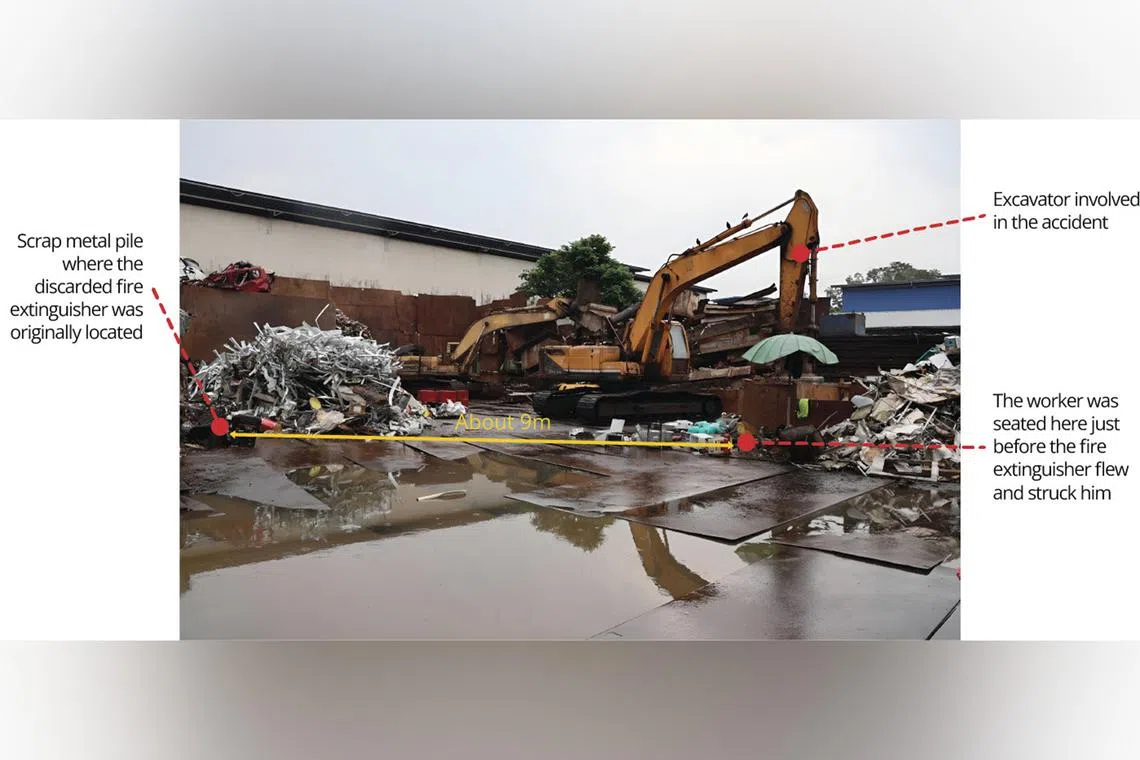Two workers died after being hit by flying gas cylinders in separate incidents in 2025
Sign up now: Get ST's newsletters delivered to your inbox

On May 15, an excavator was being used to transfer scrap metal when a discarded fire extinguisher cylinder containing carbon dioxide suddenly flew and struck a worker seated nearby.
PHOTO: WORKPLACE SAFETY AND HEALTH COUNCIL
- Two workers died in separate incidents in the first half of 2025 after being struck by flying compressed gas cylinders, according to the WSH Council.
- One incident involved a gas cylinder from a fire suppression system; another, an excavator rupturing a discarded fire extinguisher's valve connector.
- The WSH Council urged companies to implement risk control measures for gas cylinders, including regular checks and secure handling.
AI generated
SINGAPORE - Two workers died in the first half of 2025 after they were struck by flying compressed gas cylinders in separate incidents, the Workplace Safety and Health (WSH) Council said on Aug 6.
In the first incident, a worker had on March 28 removed a cylinder containing carbon dioxide from a newly installed fire suppression system, after the system triggered a false fire alarm.
The cylinder was then placed upright and free-standing on the ground, and shortly after it flew and struck another worker standing nearby.
The worker who was hit was taken to a hospital, where he died.
In the second incident, which occurred on May 15, an excavator was being used to transfer scrap metal when a discarded fire extinguisher cylinder containing carbon dioxide suddenly flew and struck a worker seated nearby.
The injured worker was taken to a hospital and later died.
The WSH Council said in its advisory that the cylinder’s valve connector likely broke when the excavator’s electromagnet pressed on a scrap metal pile.

The position of cylinder in March 28 incident before it was disconnected.
PHOTO: WORKPLACE SAFETY AND HEALTH COUNCIL

The position where the cylinder landed after it flew in March 28 incident.
PHOTO: WORKPLACE SAFETY AND HEALTH COUNCIL
“This would have caused the residual gas to suddenly discharge and turn the cylinder into a projectile,” said the council, which is a statutory body under the Ministry of Manpower.
In another accident on July 28, a ruptured compressed gas cylinder caused an explosion at a workplace. No one was injured in this incident.
The WSH Council urged companies with work activities involving gas cylinders to put in place the necessary risk control measures, given that the sudden release of high-pressure gas from such cylinders can turn them into projectiles and severely injure nearby workers.
“These accidents underscore the risks associated with the use, handling and management of compressed gas cylinders,” it added.
The council said companies that work with such cylinders should conduct regular checks for physical damage and signs of leakage, especially at valve connectors and fittings, and put in place safe work procedures to ensure that they are properly handled, transported and stored.
These procedures include securing the cylinders to a wall bracket or other fixed support, and not leaving them free-standing.
When moving them, the cylinders should be kept upright and never be rolled, slid or dragged, as this may result in physical damage.
Pressure regulators should also be removed and the gas cylinders’ valve connectors should be protected with safety caps before they are transported, added the council.
“The WSH Council urges all companies handling metal waste to review their risk assessments and implement the necessary control measures to protect their workers from harm,” it said.


